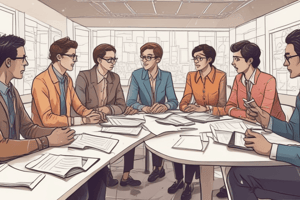Podcast
Questions and Answers
What is the definition of a group according to the provided flashcards?
What is the definition of a group according to the provided flashcards?
Two/Three or more people with a common relationship
What is the key difference between a group and a team?
What is the key difference between a group and a team?
A team consists of two or more people who work interdependently over some time period to accomplish common goals related to some task-oriented purpose.
Which of the following is NOT a key component of a team?
Which of the following is NOT a key component of a team?
- Shared leadership
- Accountability for some sort of work
- Individual performance evaluation (correct)
- Specific task-related purpose or mission
Continuous problem solving is an essential characteristic of a team.
Continuous problem solving is an essential characteristic of a team.
Self-managed teams operate under the constant supervision of a manager.
Self-managed teams operate under the constant supervision of a manager.
What does the term "Punctuated Equilibrium Model" refer to in team development?
What does the term "Punctuated Equilibrium Model" refer to in team development?
Which type of task interdependence requires the highest level of interaction and coordination among team members?
Which type of task interdependence requires the highest level of interaction and coordination among team members?
Team composition refers to the number of members in a team.
Team composition refers to the number of members in a team.
What is the role of a team member's personality in team effectiveness?
What is the role of a team member's personality in team effectiveness?
Which diversity approach argues that similar individuals are more attracted to each other, potentially creating challenges for diverse teams?
Which diversity approach argues that similar individuals are more attracted to each other, potentially creating challenges for diverse teams?
Team size is equally beneficial for all types of teams, regardless of their purpose or task.
Team size is equally beneficial for all types of teams, regardless of their purpose or task.
What are norms in a team context?
What are norms in a team context?
Process gain refers to a situation where a team underperforms based on the capabilities of its individual members.
Process gain refers to a situation where a team underperforms based on the capabilities of its individual members.
Which type of teamwork process focuses on activities that occur as the taskwork is being accomplished?
Which type of teamwork process focuses on activities that occur as the taskwork is being accomplished?
What are team states?
What are team states?
Transactive memory is how an individual remembers information for a team.
Transactive memory is how an individual remembers information for a team.
Flashcards
Group
Group
Two/Three or more people with a common relationship.
Team
Team
Consists of two or more people who work interdependently over some time period to accomplish common goals related to some task-oriented purpose.
Shared leadership
Shared leadership
A key component of a team where leadership responsibilities are distributed among team members.
Specific task-related purpose or mission
Specific task-related purpose or mission
Signup and view all the flashcards
Accountability for some sort of work
Accountability for some sort of work
Signup and view all the flashcards
Continuous problem solving
Continuous problem solving
Signup and view all the flashcards
Effectiveness is measured as a team
Effectiveness is measured as a team
Signup and view all the flashcards
Dependence on one another
Dependence on one another
Signup and view all the flashcards
Flexible
Flexible
Signup and view all the flashcards
Work teams
Work teams
Signup and view all the flashcards
Management teams
Management teams
Signup and view all the flashcards
Parallel Teams
Parallel Teams
Signup and view all the flashcards
Project Teams
Project Teams
Signup and view all the flashcards
Action Teams
Action Teams
Signup and view all the flashcards
Self-managed Teams
Self-managed Teams
Signup and view all the flashcards
Virtual Teams
Virtual Teams
Signup and view all the flashcards
Stages of Team Development
Stages of Team Development
Signup and view all the flashcards
Forming
Forming
Signup and view all the flashcards
Storming
Storming
Signup and view all the flashcards
Norming
Norming
Signup and view all the flashcards
Performing
Performing
Signup and view all the flashcards
Adjourning
Adjourning
Signup and view all the flashcards
Punctuated Equilibrium Model
Punctuated Equilibrium Model
Signup and view all the flashcards
Task Interdependence
Task Interdependence
Signup and view all the flashcards
Pooled Interdependence
Pooled Interdependence
Signup and view all the flashcards
Sequential Interdependence
Sequential Interdependence
Signup and view all the flashcards
Reciprocal Interdependence
Reciprocal Interdependence
Signup and view all the flashcards
Goal Interdependence
Goal Interdependence
Signup and view all the flashcards
Outcome Interdependence
Outcome Interdependence
Signup and view all the flashcards
Team Composition
Team Composition
Signup and view all the flashcards
Member Roles
Member Roles
Signup and view all the flashcards
Leader-staff teams
Leader-staff teams
Signup and view all the flashcards
Team task roles
Team task roles
Signup and view all the flashcards
Team building roles
Team building roles
Signup and view all the flashcards
Individualistic roles
Individualistic roles
Signup and view all the flashcards
Study Notes
Team Dynamics and Teamwork
- Group: Two or more people with a shared relationship.
- Team: Two or more individuals who work together over time toward common goals related to a specific task. Key features include interdependent work, shared leadership, a specific task-oriented purpose, accountability, continuous problem-solving, and evaluation based on collective performance.
- Shared Leadership: A key aspect of teams where leadership responsibilities are distributed among members.
- Specific Task-related Purpose or Mission: A clear, defined goal the team aims to achieve.
- Accountability: Team members are responsible for their contributions to the team's objectives.
- Continuous Problem Solving: The ongoing process of identifying and resolving issues as a team.
- Effectiveness Measured as a Team: Success is evaluated based on collective performance, not individual contributions.
- Dependence on One Another: Team members rely on each other to achieve goals.
- Flexible: Teams can quickly assemble and adapt for specific problems or projects.
Types of Teams
- Work Teams: Formed to accomplish specific tasks or projects.
- Management Teams: Managers working together to achieve organizational objectives.
- Parallel Teams: Operate alongside regular teams to address specific issues.
- Project Teams: Formed for the duration of a project to achieve specific goals.
- Action Teams: Formed to complete tasks demanding immediate action.
- Self-managed Teams: Work with reduced supervision and significant responsibility.
- Virtual Teams: Use technology to connect dispersed team members.
Team Development Stages
- Forming: Team members establish boundaries and understand expectations.
- Storming: Conflicts arise due to commitment to individual ideas and relationships.
- Norming: Team members recognize the need to collaborate to achieve goals.
- Performing: Team members are comfortable in roles and progress toward goals efficiently.
- Adjourning: Temporary groups disband; the focus is on preparing for separation.
- Punctuated Equilibrium Model: Team development with periods of stability punctuated by bursts of change.
Team Interdependence
- Task Interdependence: The degree to which members interact and rely on each other for information, resources, and materials.
- Pooled Interdependence: Lowest coordination; independent work with combined outputs.
- Sequential Interdependence: Tasks completed in a prescribed order; interaction between adjacent tasks only.
- Reciprocal Interdependence: Highest interaction and coordination among members for tasks.
- Goal Interdependence: Shared vision and alignment of individual goals with the team's goals.
- Outcome Interdependence: Members share rewards earned by the team.
Team Composition, Member Attributes, and Diversity
- Team Composition: The mix of individuals on a team.
- Member Roles: Expected behaviors within a context.
- Leader-staff Teams: Leader makes decisions, members perform tasks.
- Team Task Roles: Behaviors facilitating task accomplishment.
- Team Building Roles: Behaviors influencing team social climate.
- Individualistic Roles: Behaviors benefiting the individual at the team's expense.
- Member Ability: Physical and cognitive abilities vary amongst members.
- Disjunctive Tasks: Superior ability member has maximum influence.
- Conjunctive Tasks: Team performance depends on the weakest link.
- Additive Tasks: Member abilities accumulate to determine team performance.
- Member Personality: Team members have varied personality traits.
- Agreeableness, Conscientiousness, Openness to Experience: Personality traits generally correlated with better team performance.
- Team Diversity: Degree of difference among members.
- Value in Diversity Problem-solving Approach: Diverse teams benefit from a wider range of knowledge and perspectives.
- Similarity-attraction Approach: Diversity creates challenges as individuals tend to be drawn to similar others.
- Surface-level Diversity: Observable attributes (race, ethnicity, sex, age).
- Deep-level Diversity: Less observable attributes (values, attitudes).
- Team Size: Larger size can be beneficial for management/project teams but not production tasks.
Teams: Norms, Processes, and States
- Norms: Acceptable standards of behavior shared by group members.
- Performance, Appearance, Social Arrangement, Allocation of Resources: Areas in which norms are established.
- Explicit Statements, Critical Events, Primacy, Carry-over: Factors influencing norm development.
- Facilitate Group Survival, Increase Predictability, Reduce Embarrassing Problems, Express Values: Examples of common norms.
- Team Process: Activities and interactions within the team contributing to goals.
- Process Gain: Team outcomes exceed expected outcomes based on members' capabilities.
- Process Loss: Team outcomes are less than expected.
- Coordination Loss: Time/energy for coordination reduces time/energy for tasks.
- Motivation Loss: Individuals exert less effort in teams than working alone.
- Taskwork Processes: Activities related to task accomplishment.
- Creative Behavior, Decision Making, Boundary Spanning: Teamwork processes.
- Transition Processes, Action Processes, Interpersonal Processes: Team processes that occur in different stages.
- Team States: Feelings & thoughts coalescing in team members resulting from experiences working together.
- Cohesion: Emotional bonds among team members.
- Potency: Team members' belief in team effectiveness across scenarios.
- Mental Models: Shared understanding of team and task.
- Transactive Memory: Specialized knowledge distributed among members for team memory efficiency.
Studying That Suits You
Use AI to generate personalized quizzes and flashcards to suit your learning preferences.
Description
Explore the essential concepts of team dynamics and teamwork in this quiz. Understand the differences between groups and teams, the importance of shared leadership, accountability, and continuous problem-solving. Test your knowledge on how team effectiveness is measured and the interdependence within team roles.





